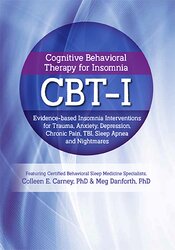

Watch this breakthrough Cognitive Behavioral Therapy for Insomnia (CBT-I) Intensive Training to develop core competencies and master the art of applying CBT-I to a variety of clinical populations!
You’ll get effective clinical techniques from two of today’s leading CBT-I treatment innovators, Colleen E. Carney, Ph.D. and Meg Danforth, Ph.D., who will share their insight and techniques. Join in for this revolutionary course as both reveal the latest advances in CBT-I to get the skills you need to succeed.
You will be able to utilize concrete strategies that will provide greater healing for your clients who suffer from:
Discover evidence-based strategies to help your clients increase energy during the day, sleep more deeply, and re-initiate sleep after hot flashes, panic attacks or nightmares. The strategies that you will add to your toolbox can be easily integrated into existing treatment for depression, chronic pain, trauma and anxiety.
Through case studies, interactive discussions, examples of sleep logs, and reproducible handouts, you will take away practical CBT-I strategies to use immediately with any client. Finish this course armed with tools you can use in your very next session.
PESI Australia, in collaboration with PESI in the USA, offers quality online continuing professional development events from the leaders in the field at a standard recognized by professional associations including psychology, social work, occupational therapy, alcohol and drug professionals, counselling and psychotherapy. On completion of the training, a Professional Development Certificate is issued after the individual has answered and submitted a quiz and course evaluation. This program is worth 19.0 hours CPD for points calculation by your association.
| File type | File name | Number of pages | |
|---|---|---|---|
| Manual (9.2 MB) | 110 Pages | Available after Purchase | |
| Extra Handout (2.22 MB) | 23 Pages | Available after Purchase | |
| Day 1 B/W slides (5.69 MB) | 95 Pages | Available after Purchase | |
| Day 2 B/W slides (4.40 MB) | 73 Pages | Available after Purchase | |
| Day 3 B/W slides (11.63 MB) | 102 Pages | Available after Purchase | |
| Day 1 B/W slides - French (5.69 MB) | 95 Pages | Available after Purchase | |
| Day 2 B/W slides - French (4.40 MB) | 73 Pages | Available after Purchase | |
| Day 3 B/W slides - French (11.63 MB) | 102 Pages | Available after Purchase | |
| Extra Handout - French (2.22 MB) | 23 Pages | Available after Purchase | |
| Manual - French (9.2 MB) | 110 Pages | Available after Purchase | |
| Day 1 B/W slides - Italian (5.69 MB) | 95 Pages | Available after Purchase | |
| Day 2 B/W slides - Italian (4.40 MB) | 73 Pages | Available after Purchase | |
| Day 3 B/W slides - Italian (11.63 MB) | 102 Pages | Available after Purchase | |
| Extra Handout - Italian (2.22 MB) | 23 Pages | Available after Purchase | |
| Manual - Italian (9.2 MB) | 110 Pages | Available after Purchase |

Meg Danforth, Ph.D., CBSM, is a licensed psychologist and certified behavioral sleep medicine specialist who provides advanced clinical care to patients with sleep disorders and comorbid medical and mental health issues. She is a clinician and educator at Duke University Medical Center in Durham, NC. As the Director of the Duke Behavioral Sleep Medicine Clinic, she has been helping people sleep better without medication for the past 15 years. She also provides clinical training and supervision to psychology graduate students, interns, and fellows. Dr. Danforth is committed to teaching clinicians from a variety of backgrounds to deliver CBT-I in the settings in which they practice. Her work has been featured in the Associated Press and CBS News.
Speaker Disclosures:

Colleen E. Carney, PhD, is on faculty in the department of psychology at Toronto Metropolitan University, where they are the director of the sleep and depression laboratory. They are a leading expert in psychological treatments for insomnia, particularly in the context of co-occurring mental health issues. Their work has been featured in The New York Times and they have over 100 publications on insomnia.
Dr. Carney frequently trains students and mental health providers in CBT for Insomnia at invited workshops throughout North America and at international conferneces. Dr. Carney is a passionate advocate for improving the availability of treatment for those with insomnia and other health problems. For more information, please visit www.drcolleen carney.com
Speaker Disclosures:
Financial: Dr. Colleen Carney has employment relationships with Toronto Metropolitan University and Duke University. They receive a grant from Canadian Institutes of Health Research, Team Research, and Sleep Research Consortium and received Faculty of Arts Travel Award. Dr. Carney receives royalties as a published author. They receive a speaking honorarium and recording royalties from PESI, Inc. Dr. Carney has no relevant financial relationships with ineligible organizations.
Non-financial: Dr. Colleen Carney is a member of the Canadian Association of Cognitive and Behavioural Therapies, the Canadian Psychological Association, the Association for Behavioural and Cognitive Therapies (ABCT), the Canadian Sleep and Circadian Network, the Canadian Sleep Society, the Sleep Research Society, and the Canadian Association for Cognitive Behaviour Therapy.
Please wait ...